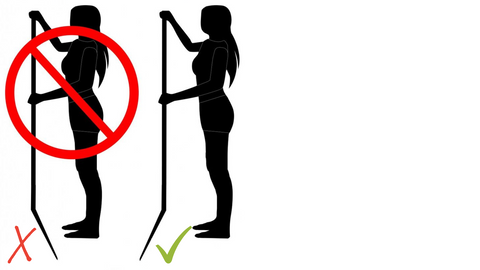Common Rookie Mistakes
Paddle boarding is an all inclusive sport, anyone can do it. It can be challenging, fun, funny, exciting and relaxing, all in one paddle too!
We love seeing more people getting into paddle boarding and think it's bloody terrific seeing all sorts experiencing the Moana.
Once you've bought yourself a board, it's relatively easy to get out there and start exploring your local waters, with little or no experience. Here's where this pearl of wisdom below comes in.
We've all had to be a Rookie at some point and to help you look like less of a kook out there, and keep you and your board safe, we've made a list of common mistakes that you should avoid:
1. Paddling without a Buoyancy Aid and/or a leash.
There's no excuses when it comes to safety, many perfect mornings can turn to custard fast and it doesn't matter how confident of a swimmer you are. Having a buoyancy aid and a leash are crucial pieces of your safety kit that you shouldn't be with out.
Take a look at the NZSUP Safe Code

And here's a video from Sup Connect 'a-perfect-example-of-why-paddle-boarders-must-always-wear-a-leash' Take a look around the 4:40 mark to see just how fast things can go wrong out there.
Stay safe Whānau!
2. Not inflating your Inflatable SUP to the recommended psi.
When you first start out paddle boarding can be challenging, you may be using new muscles you've never engaged before so there's no need to make it harder!
Take a look to see the manufacturers recommended psi for your board.
It can be hard mahi when pumping up your board for the first time and you often find newbies doing the 'feel test' and thinking that'll do, when in fact they still have a bit to go. Having your inflatable SUP looking like a banana out on the water will mean a difficult paddle for anyone, let alone a newbie!
Here's a handy User Manual that has some good nuggets of wisdom on inflating your board and remember make sure your value is back up/closed before you start pumping so you don't lose air when disconnecting the hose.

Avoid 'The Banana effect'!
3. Paddling with your paddle backward.
Seems simple right, but it happens all the time. We've all been there! and all had a laugh. So why does this happens so often? Possibly due to the fact that we end up starting on our knees and holding the paddle down closer to the blade, we're not holding the T-grip (top of the handle) cause if we were we would notice that it feels a bit off. Also many assume the paddle goes a certain way to help scoop the water. Hey, if you've never done it before how would you know?

Check out this handy video to see How to hold your paddle correctly.
4. Paddling right into the sand and/or rocks.
Many have this picture of themselves paddling to shore and casually jumping from their board to the sand gracefully, but it's more than often not the case.
Not only is it bad for your board and fins, even a sandy beach can have shells or debris that can starch your board. Fins also get bent and damaged when they get stuck in the sand and your board goes slightly sideways.
It's also not ideal for you. When your board hits the sand and you're still on top you tend to get propelled forward, not looking so cool now are we?! Also it's not so easy to judge the depth of the water and you may injure yourself by jumping off onto much shallower or much deeper water than expected, or jumping onto something that you couldn't see.
Instead when you get close to the shore go back down to your knees, that way you can easily slide off before beaching up.

5. Ratcheting your board to your roof.
It seems like a good idea to make sure you board is tightly secured to your roof, but ratchet straps can end up damaging your boards, you don't always realise how tight you're going.
We've seen hard boards cracked and inflatable SUPs pierced from people over tightening. Instead just use your standard tie downs that you tighten by hand, that way you won't run the risk of damaging your board.
One more tip here when you're putting your board on the car, van, or makeshift bike trailer...fins up!

6. Not checking the weather forecast.
The weather especially wind (strength and direction) and tides can have a massive impact on your paddling experience, and even whether or not you should head out. Most stand up paddle boarders don't want to be battling against a strong wind or tide for their paddle.
There are multiple sites and apps you can check before getting to your paddle destination, often pays to check more than one. Here a few we use Windy, Predict Wind, Swell Map, Met Service, our local Port Beacon and webcams.
Get to know your local spot when it comes to tides, choose a paddle course where you go with the water, knowledge about what tidal currents could put you off course is super handy. If it's a new spot go hit up the local SUP shop to get the low down. We're always happy to have a chat.
And of course the last check before heading out use your own eyes.
Here's a basic guideline:
- Less than 6 knots (less than 11.5km/h) is ideal flat water conditions
- At 8-10 knots (14.8-18.5km/h) white caps begin to appear.
- At 15 knots (27.8km/h) white caps are more frequent and small waves will form.
- At 20-25 knots (37-46km/h), more experienced paddlers may want to use the wind to surf downwind
Keeping in mind that an inexperienced paddler will start to struggle in an head or side wind of around 6 knots an hour.
Side note: knots is a nautical term, in many surf apps/sites you will find km/h. Make sure you look at what measurements they're using.
7. Not rinsing your gear off in freshwater and leaving it direct sunlight
Make sure to show your board and gear some TLC.
Paddling in the magnificent moana is an amazing experience, exploring the coastlines can give you endless adventures, but the moana can also be rough on our gear. Sand and salt can get into all the nooks and crannies and cause havoc.
Remember to give your board, leash, paddle, and buoyancy aid a rinse with freshwater after an ocean paddle and let it all dry out. If there's no hose at your local watering hole, rinse everything off at home.
And just like us our boards need to be protected from this harsh sun of ours when were not using it. Whenever it's kept until the next paddle, make sure it's not hanging out in direct sunlight for extended periods of time as this can cause unnecessary UV, heat, and weather damage.
Doing these small housekeeping chores along the way will ensure you get the most life out of your SUP and gear.

8. Dragging your board on land
Unfortunately we see it more often than we would like to. I mean we understand they're big boards and it can be heavy work lugging them around. However dragging your board can end in damage.
You may think that fine sand or soft grass can't hurt but you never know what debris may be hiding out ready to scratch or scuff up your SUP. If you have a hard time getting your SUP from point A to point B, maybe think of investing in some carry straps or a SUP trolley to make it easier on you and your board.


Also remember once you've deflated and rolled up your inflatable SUP, again don't drag it. Dragging it can cause a lot of damage on those folded seams.
9. Not paddling within your ability
As we said at the start it's relatively easy to get out on the water once you've got a board, and if you've never gone for a paddle before it's hard to know how far is too far. Scenarios can often begin with 'let's take a look around that point, or that island or over to that sand bar' it may seem closer than you think.
It's not only the distance, but the water conditions and also the condition of you! If you've never paddled before or maybe you tried it once last summer, your muscles won't be used to paddling and you could over-cook yourself half way through your paddle.
Be kind to yourself, start easy and gradually customise your body to longer paddles.

